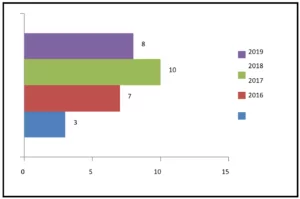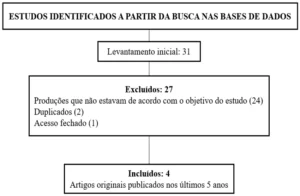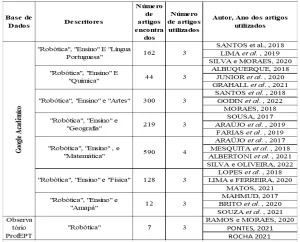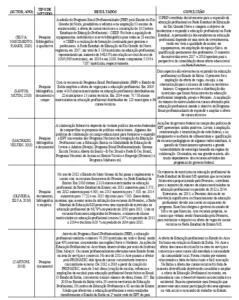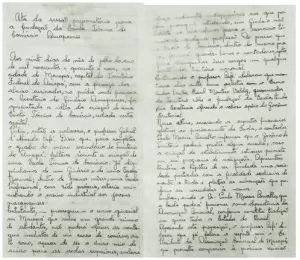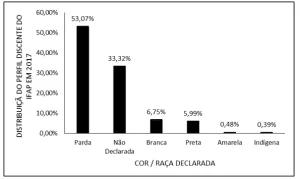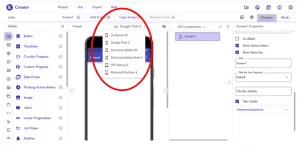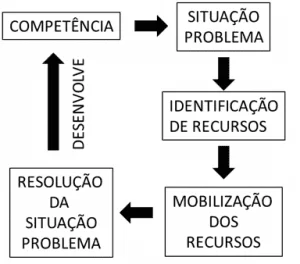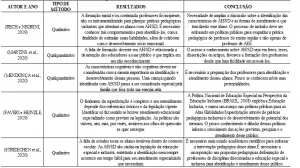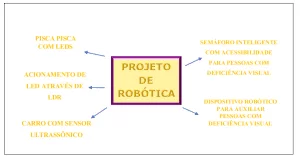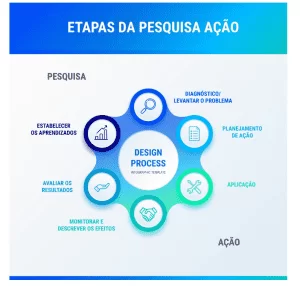LITERATURE REVIEW
CARDOSO, Ana Carolina Grangeia [1]
CARDOSO, Ana Carolina Grangeia. Didactics and its contributions to teaching practice. Revista Científica Multidisciplinar Núcleo do Conhecimento. Year 06, Ed. 08, Vol. 05, pp. 05-17. August 2021. ISSN: 2448-0959, Access link: https://www.nucleodoconhecimento.com.br/education/contributions
ABSTRACT
This article aims to understand the main contributions of didactics to teaching practice, based on the following guide question: what elements of didactics can foster the improvement of teachers’ performance? Thus, a bibliographical research was carried out on the theme focusing on the theoretical aspects of its emergence, definition of educational objectives, educational planning, selection and organization of content, teaching methods and evaluation of learning. Thus, it is concluded that all educators and professionals in the area need to know the elements related to didactics that can help in the improvement of teaching work in order to improve the quality of education.
Keywords: didactics, educators, teaching work.
INTRODUCTION
Although there are already indications of elementary forms of education and learning throughout the history of education, the term “didactics” arises when adults began to intervene in the learning activity, defining it as a planned and intentional activity. In this context, a process of establishing teaching principles and rules began, seeking to improve teacher performance and develop the ability to identify how students learn (LIBÂNEO, 2013). Therefore, it is necessary to know and recognize the various techniques and existing educational methods that promote the improvement of the quality of education.
Didactics can be situated in the set of pedagogical knowledge with a significant role in professional training for the exercise of teaching (LIBÂNEO, 2013). Through it, teachers acquire the teachings necessary for the development of their practice. The teaching process, the object of study of Didactics, cannot be considered as an activity restricted to the classroom. Therefore, teachers need to know the organizational methods and forms of teaching, as well as the guidelines that regulate and guide their process (LIBÂNEO, 2013).
It is essential that educators appropriate didactics as a mediating element of their work. Therefore, the aim of this article is to understand the main contributions of didactics to teaching practice, based on the following guide question: what elements of didactics can foster the improvement of teachers’ performance? To this end, this work focuses on the theoretical aspects of its emergence and the issues that involve the choice of educational objectives, educational planning, content selection and organization, teaching methods and learning evaluation, based on a literature review on the subject.
By understanding Didactics as a discipline of teacher education, it seeks, with this work, that education professionals find here the theoretical foundation necessary to build their practices in order to make the teaching and learning process as significant as possible to students.
DIDACTICS: A BRIEF HISTORY AND ITS MEANING
Concern about ways to teach and learn is not recent. Historical records show that the first educator, Plato, emerged in Ancient Greece.Since the 6th century, the role of the Church in education stands out, which began to devote its time to the creation of schools to guarantee the Christian formation of people in the great European cities. During the 19th century. XI and XII, with the need to meet commercial interests, the control of formal education escapes the hands of the Church (MALHEIROS, 2019).
The constitution of the school by series, as we know it today, was introduced with the Jesuits in the Modern Age. The process of separating the classes began in the 19th century. XVII, when it began to be divided into primary education (popular classes) and secondary education (bourgeoisie) (MALHEIROS, 2019).
The 21st century. XII was the landmark of Didactics with the publication of didacta magna de comênio. This publication aimed to structure the ways of teaching, defending an idea of universalization of teaching. After Comênio, some theorists presented important concepts for the development of the teaching process, such as Rousseau, Pestalozzi and Herbart. According to Libâneo, Comênio was the “first educator to formulate an idea of the dissemination of knowledge to all and to create principles and rules of teaching” (LIBÂNEO, 2013, p.60).
the term Didactics appears when adults begin to intervene in the learning activity of children and young people through the deliberate and planned direction of teaching, contrary to the more or less spontaneous forms of intervention before. Establishing a properly pedagogical intention in the teaching activity, the school becomes an institution, the teaching process becomes systematized according to levels, in order to adapt to the possibilities of children, the ages and rhythms of assimilation of studies (LIBÂNEO, 2013, p.59).
Rousseau (1712-1228), according to Malheiros (2019), preached that education should prepare the child for adulthood with real needs as a structure. For him, the learning process is a natural process, linked to biological development. In the same sense, Libâneo (2013) says that teaching should be aimed at the interests of children who are good by nature.
Years later, Pestalozzi (1746-1827) developed a teaching method, in which he defended observation and analysis as ways to capture reality, leading the child to construct his own meanings about the various phenomena, which should be expressed and evaluated through language (MALHEIROS, 2019). Pestalozzi put Rousseau’s ideas into practice. His teaching method was based on intuition, cultivation of feeling, mind and character (LIBÂNEO, 2013). After Pestalozzi, another prominent name in didactic studies was Herbert. He was influenced by Rousseau, Pestalozzi and Comênio (MALHEIROS, 2019).
Herbert (1766-1841) had the objective of formulating a unique teaching method that would serve all people, prioritizing the organization of teaching practice, such as: “the need to structure and organize the teaching process, the need to understand the subjects studied and not simply memorization and the educational meaning of the discipline in character formation” (LIBÂNEO, 2013, p 63). At that moment, we sought to direct instructional actions by the way people learn (LIBÂNEO, 2013).
From the 19th century. XIX and early 19th century. XX, Contemporary Age, the demand for a uniform culture arises. The contemporary school is constructed based on the following guidelines: clearly defined school spaces, rigid schedules, selection of appropriate content for each grade, deprecation of non-institutionalized teaching practices, mandatory attendance and evaluation and certification of learning (MALHEIROS, 2019). Still in the 19th century, Didactics began to seek foundations in science, especially in Biology and Psychology. Thus, the Pedagogy of the “New School” emerges, in which the student educates himself and is the subject of learning, while the teacher is the teacher, advisor and organizer of learning situations (GIL, 2018).
The New School intended to be a movement of pedagogical renewal of a fundamentally technical nature, which sought to apply in educational practice the knowledge derived from the behavioral sciences. In fact, from the second decade of the 20th century, Didactics followed the postulates of the New School. With this perspective affirmed the need to start from the spontaneous and natural interests of the child, began to value the principles of activity, freedom and individualization. The view that the child is a miniature adult has been abandoned… (GIL, 2018, p. 3)
In Brazil, the ideas of the New School were very prestigious after the Revolution of 1930 through Fernando de Azevedo, Anísio Teixeira and Lourenço Filho. The period from 1950 to 1970 is marked by the use of teaching methods and techniques with the aim of ensuring the efficiency of students’ learning and the defense of scientific neutrality (technicality). Therefore, Didactics, as a discipline, began to emphasize the elaboration of teaching plans, formulation of instructional objectives, selection of contents, exhibition techniques, etc. (GIL, 2018).
Over the years and with the improvement of studies in the area of education, the field of didactics begins to be delineated in a solid way. Common sense believes that education only happens in school. However, formal education takes place in school, marked by the characteristics of intentionality, systematization, organization and social relationship, a systematic form of education. On the other hand, informal education is one that does not occur in an organized space and time, an unsystematic way (MALHEIROS, 2019). In this perspective, Libâneo (2013) situates formal education within institutions (school) that promote education intentionally and, consequently, guide their activities in order to make them more efficient, through planning, definition of methods, selection of contents and definition of evaluation processes.
In this scenario, Pedagogy and Didactics are strictly linked. The first is the art and science of education. The second is the science and art of teaching. Didactics is, therefore, the study of the entire teaching process and its results (MASETTO, 1997) that manifests itself “when adults begin to intervene in the learning activity of children and young people through the deliberate and planned direction of teaching, unlike the more or less spontaneous forms of intervention before” (LIBÂNEO, 1994, p.58).
Didactics is a fundamental element in the systematic form of education, because it allows the teacher to perform all the steps to conduct a class: teaching process (class stages); teaching methods; learning procedures; teaching materials; management of the teaching situation (LIBÂNEO, 1994). Therefore, the understanding of the history of education and the evolution of Didactics reveals its importance for educators and for the improvement of the teaching process.
EDUCATIONAL PLANNING: PERSPECTIVES AND APPLICATIONS
Planning is a “process of rationalization, organization and coordination of teaching action, articulating school activity and the problem of the social context” (LIBÂNEO, 2013, p. 246) and, therefore, is an important field of study for educational institutions and teachers. According to Malheiros (2019), educational planning can be understood as the organization of the steps that will be taken to achieve a certain objective, being divided into educational plan and teaching plan.
Also according to Malheiros (2019), within the educational planning we find the following plans: educational, school, curriculum and teaching. For him, the educational plan has greater scope, because it deals with political and philosophical issues of the act of teaching. In this sense, it is a systemic process that takes place at the national, state and local levels. Such a plan needs to become a plan at the local level. Therefore, all schools must build a school plan, that is, a plan that is done more comprehensively for the reality of a given institution (MALHEIROS, 2019).
According to Haydt (2006) there is a cycle for building a school plan: probing and diagnosis of reality; definition of school objectives and priorities; organization of the school routine; construction of the course plan; definition of the disciplinary system; assignment of functions to members of the pedagogical team.
Curriculum planning is within educational planning. It is the organization of the content that will be worked over a certain period. The curricular organization should express coherence between contents and respect for the potential of students. The teaching plan presents in detail the activities that the teacher will perform and propose the class in order to achieve the objectives. For this, the teacher must be clear of four questions: objectives, contents, methods and space (MALHEIROS, 2019).
The preparation of the teaching plan, according to Malheiros (2019), provides numerous advantages to the teacher, such as: ease in fulfilling the proposed activities; simplicity of knowing what needs to be evaluated; organization of ideas; explanation of the steps to stakeholders. It is composed of objectives, contents, procedures and resources and must possess the characteristics of coherence, continuity, objectivity and precision. To develop a teaching plan it is necessary to follow the following steps: diagnosis; construction of the plan; implementation of the plan; evaluation of the plan.
Teaching planning is divided into other more detailed plans: course, unit, and class. Course planning is the prediction of all the knowledge that a particular group of students will be led to build in a specific period of time (semester or school year). It must contain: course objectives; content; teaching procedures; resources; time and evaluation (MALHEIROS, 2019).
The planning of the unit is the prediction about how all classes dealing with the same subject will take place (MALHEIROS, 2019). Pilleti (1985) says that the planning of a didactic unit should provide for three stages: presentation, development and integration.
Finally, lesson planning is the detailing of each of the classes and has the following functions: definition of the objective of the class; detailing the content; description of the procedure; time; evaluation of the class (MALHEIROS, 2019).
In addition to Malheiros (2019), other authors also bring contributions in their works regarding educational planning. For Gil (2018), there are four levels of planning: educational, institutional, curricular and teaching. Educational planning, in the theoretical view, takes place at a broader level, because it has philosophical bases and defined the last ends of education and the means to achieve it. In addition, it can be developed at the Federal, State and Municipal levels.
Institutional planning is carried out jointly by all professionals of a school with the purpose of meeting the guidelines of national education, as well as the local and specific needs of its clientele. Through it, it is possible to identify the philosophy of work, mission, pedagogical guidelines, among other aspects of the school.From it, the Political Pedagogical Project (GIL, 2018) is born.
Like Malheiros (2019), Gil (2018), I defined curriculum planning as the organization of the set of actions that need to be developed within each course, in order to promote the teaching-learning process as much as possible. The next level of planning, according to Gil (2018), is teaching. This planning, the responsibility of the teacher, “is based on curriculum planning and aims at the systematic direction of activities to be developed inside and outside the classroom…” (GIL, 2018, p. 84). The discipline plan, unit plan and lesson plan are unfolding of the teaching plan, and can be defined in the following ways:
The discipline plan was a forecast of the activities to be developed throughout the year or the academic semester… In general, the discipline plan clarifies about its duration, general objectives, programmatic content, teaching strategies, resources, didactics and evaluation procedures (GIL, 2018, p. 86)
The unity plan is a more detailed document than the discipline plan. The objectives are much more operational than those of the discipline plan, because they clearly and precisely designate the expected behaviors of the students (GIL, 2018, p .90)
What distinguishes the lesson plan from the unity plan is that it is much more restricted. In general, it is limited to the prediction of the development to be given to the content of the subject and to the teaching-learning activities proposed according to the objectives within each class (GIL, 2018, p. 91)
It is observed, therefore, that school planning unfolds at levels of coverage, focusing from the educational institution to everything that occurs in a class. Still on the planning, Libâneo (2013) divides it into: school plan, teaching plan and lesson plan. According to the author, in order for the plans to be effectively instruments of action, they must be as a guide and present sequential order, objectivity, coherence and flexibility.
The school plan consists of general guidelines of the school (general objectives, didactic guidance, clientele, pedagogical conception of the faculty, etc.). The teaching plan is the prediction of the objectives and tasks of the teaching work for a year or semester. Finally, the lesson plan is the detailing of the teaching plan, that is, the development of content for a class (LIBÂNEO, 2013)
Through the arguments exposed throughout the text it is possible to understand that the work of the teacher, as well as the work of the whole school, must be carefully planned, at various levels, so that the teaching objectives are achieved.
FORMULATION OF EDUCATIONAL OBJECTIVES
The educational practice is directed to the achievement of objectives, through an intentional and planned action (LIBÂNEO, 2013). In this sense, it is noted that the formulation of teaching objectives is a fundamental stage of the teaching work, because they anticipate results and processes expected from the whole of the work of the teacher and students. In addition, they serve to guide the teacher regarding the selection of content, the choice of teaching strategies and the elaboration of instruments for student performance evaluation (GIL, 2018).
The movement to study and formulate educational objectives began in the United States (USA) and reflects the behavioralapproach of education. The pioneers of this movement are Johann F. Herbert (1776-1841) and Herbert Spencer (1820-1903). In addition to Herbert and Spencer, other authors such as Franklin Bobbit , Ralph Tyler, Benjamin Bloom and Robert Mager have gained prominence in the field of educational goals (GIL, 2018).
Bobbit introduced the principles of Taylorism into the organization of the educational process, according to mechanistic theories and behavioralist psychology. Thus, it defined some basic principles for the development of the curriculum that are related to the formulation of educational objectives: eliminate objectives that are not practical and cannot be achieved; emphasize objectives that constitute needs for adulthood; avoid objectives that were opposed to the community; involve the community in setting goals; differentiating objectives and sequencing the objectives (GIL, 2018).
Tyler was responsible for designing objectives as the foundation of the development of the school curriculum and teaching (GIL, 2018). He has developed some questions, which teachers should consider in the development of teaching planning: what educational objectives should the school seek to achieve? What educational experiences can be helpful in achieving these goals? How to efficiently organize these educational experiences? How can we be sure that these goals are being achieved? (GIL, 2018).
Benjamin Bloom is one of the most cited authors in the papers regarding the formulation of educational objectives due to his contributions to the study of the theme with his theory of taxonomy of educational objectives (GIL, 2018).
For the author, the classification of educational objectives constitutes the basis for the planning and evaluation of the curriculum. The objectives are classified as a degree of complexity within the cognitive, affective and psychomotor area (GIL, 2018). Domains can be defined as follows:
The cognitive domain: refers to the objectives related to knowledge, information or intellectual abilities. It is the domain that is most attention paid to university courses. The affective domain covers the objectives related to feelings, emotions, likes or attitudes. The psychomotor domain, finally, involves the objectives emphasize the work of neuromuscular nature. Imitation, Manipulation, Precision, Articulation and Naturalization (GIL, 2018, p. 101).
In the same way that Bloom, Robert Mager contributed to the formulation of specific and measurable objectives. The objectives, according to the author, are known as behavioral, performance or operational and describe a person’s behavior as an intended result of an instruction (GIL, 2018).
In addition to these authors, Libâneo (2013) also develops some contributions to this theme, as it establishes the need to distinguish between general objectives and specific objectives. For the author, in a school planning, the elaboration of the general objectives is related to the school system, the school and the teacher that reflect the broader purpose about the role of school and teaching. In addition to them, the specific objectives reflect the expected results of the students.
According to the above, the contribution that these authors brought to teaching practice in terms of the formulation of educational objectives is notary. Therefore, it is up to each of the educators to absorb the best in each theory and understand how concepts, methods and techniques can provide a reflective practice.
SELECTION AND ORGANIZATION OF CONTENTS
The selection and organization of contents should be analyzed as the reciprocal action between the subject, the teaching and the student, that is, the content to be transmitted provides certain teaching procedures, which in turn enable ways of organizing the active study of students (LIBÂNEO, 2013). Teaching content can be defined as follows:
“… are the set of knowledge, skills and habits, valuable and atypical modes of social action, organized pedagogically and didactically, in view of active assimilation and application by students in their life practice. They therefore encompass concepts, facts, ideas, processes, principles, skills…” (LIBÂNEO,2013, p.142)
Thus, it is verified that the contents are organized in teaching subjects and worked by the articulation objectives-content-methods and forms of organization of teaching, within the educational and social context (LIBÂNEO, 2013).
In the selection of contents it is necessary to take into account the school program and the teacher’s personal program. According to Pilleti (1985), the criteria for content selection are: validity, meaning, usefulness, possibility of personal elaboration, feasibility and flexibility. According to Gil (2018), the criteria for selecting content are: linking to objectives; self-sufficiency; validity; significance; utility; flexibility; adaptability to student diversity and suitability for time
Libâneo (2013) also presents some principles that should be considered for content selection: correspondence between general objectives and content; scientific character; social relevance and accessibility and solidity.
Regarding the organization of the contents, it should be divided into three levels: class (one day), topic (subjects within a class) and unity (parts of the topics), considering the criteria of continuity, sequence and integration (MALHEIROS, 2019).
Therefore, the selection and organization of contents become important tasks for the teacher, as they are the informative and formative basis of the transmission-assimilation process (LIBÂNEO, 2013). They should then be carried out in a coherent and judicious manner with the social and individual needs of the students, so that the learning process takes place in a significant way, thus avoiding the overload of subjects, which often do not take into account the contents that are really indispensable to be assimilated, the students’ own assimilation capacity and the consolidation of learning (LIBÂNEO, 2013).
TEACHING METHODS
When reflecting on the main teaching methods and techniques it is important to understand, first, the meaning of these terms. Method is a planned way to reach the goal and the technique is the operationalization of the method (MALHEIROS, 2019). According to Libâneo (2013), teaching methods are determined by the relationship between objective and content, referring to the means to achieve the general and specific objectives.
Teaching methods can be classified into: exhibition, independent work, group work and other teaching methods (MALHEIROS, 2019). Below are some examples cited by Malheiros (2019) and Libâneo (2013):
- Methods of exposure: oral exposure, demonstration, illustration etc.
- Independent working methods: individual directed study, interest groups, case study
- Methods of group work: games, dramatization, debate, etc.
- Other teaching methods: Montessori, projects, constructivism.
It is observed, therefore, that all elements of didactics are interconnected. Therefore, defining the appropriate teaching methods is only possible to the extent that one has an understanding of the objectives to be achieved and the contents that should be worked on.
EVALUATION OF SCHOOL LEARNING
Luckesi (2011) defines evaluation as a qualitative judgment on the teaching-learning process. This judgment exists to assist the teacher in decision making and, therefore, can not be considered as application of tests and tests, measurement of information that the student was able to memorize and award grades to students.
For Haydt (2006) there is a clear distinction between testing, measuring and evaluating. According to the author, testing means verifying a performance through previously organized situations, called tests, while measuring is related to the description of a phenomenon from a quantitative point of view. Finally, to evaluate is to interpret quantitative and qualitative data to obtain an opinion or value judgment, based on standards or criteria.
The evaluation, according to Libâneo (2013) should be constructed in stages: verification (data collection), qualification (relationship between data) and appreciation (reflection on the results). Thus, it can reflect the real and potential advancement of the student.
Another important aspect of learning assessment is that it has a specific purpose in each phase that is performed. At the beginning of the process it is called diagnostic evaluation, because it aims to analyze the starting point, that is, what the student already knows. During the process, the formative evaluation takes place, aiming to correct the paths taken. Finally, the smoactive evaluation is performed, which analyzes the set to know if the educational objective was achieved, with a control and classification characteristic (LUCKESI, 2011).
As previously seen, Bejamin Bloom, creator of Bloom Taxonomy, also contributed his theory to the area of teaching evaluation (GIL, 2018). This study divides the domains of knowledge into: cognitive (evaluates what the student knows), affective (evaluates aspects of interpersonal relationships) and psychomotor (assesses skills for the execution of tasks).
This said, the process of evaluating school learning should be well planned and organized, as it provides numerous benefits, such as: provides the basis for planning; adjusts curricular policies and practices, establishes learning situations; improves learning and teaching, among other aspects (SANT’ANNA, 2014).
FINAL CONSIDERATIONS
Throughout the studies on Didactics and its main elements, it is noted its contribution to the work of education professionals. It offers a theoretical and practical contribution indispensable to teacher training, as it clarifies the conditioning factors of the education and teaching process and, at the same time, offers subsidies for the exercise of the teaching task (LIBÂNEO, 2013).
This article sought to contribute to teachers to recant their practices from the reflection on the history of didactics and its elements that promote the improvement of teachers’ performance, namely: educational objectives, educational planning, content selection and organization, teaching methods and evaluation of school learning.
Understanding and awareness of the use of aspects of didactics in teaching practice, combined with the reality of the institution and students, will make learning really meaningful for all those involved in the learning teaching process.
REFERENCES
GIL, Antonio Carlos. Didática no Ensino Superior. São Paulo: Atlas, 2018.
HAYDT, R.C.C. Curso de Didática Geral. 8 ed. São Paulo: Ática, 2006.
LIBÂNEO, José Carlos. Didática. São Paulo: Cortez, 2013.
LUCKESI, Cipriano Carlos. Avaliação da Aprendizagem Escolar: Estudos e Proposições. 22 ed. São Paulo: Cortez, 2011.
MALHEIROS, Bruno Taranto. Didática Geral. Rio Janeiro: LTC, 2019.
PILLETI, N. Didática Geral. São Paulo: Pioneira, 1985.
SANT’ANNA, Ilza Martins. Por que avaliar? Como avaliar? Critérios e Instrumentos. 17 ed. Petrópolis, RJ: Vozes, 2014.
[1] Pedagogue and Master in Education from fluminense Federal University. Specialist in School Management (administration, supervision and guidance) and Public Management.
Submitted: May, 2021.
Approved: August, 2021.

